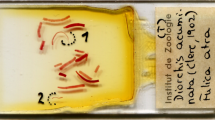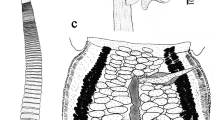Abstract
This fourth paper in a series revising the type-specimens of “older” species of the genus Dicranotaenia Railliet, 1892 sensu Spassky & Spasskaya (1954) presents new data on the type-specimens of the D. mergi (Yamaguti, 1940) from Mergus serrator L. and M. merganser L. The re-examined holotype from Tokyo has shown that the spinous cirrus is 98–135 μm long with a spherical or club-shaped dilatation at its distal end. The shape of this organ differs considerably from the cirrus of D. coronula (Dujardin, 1845), which has a bulbous dilatation in its mid-part. In addition, these species differ in the shape of the aperture of the pars copulatrix vaginae and in other characters. The author therefore includes D. mergi among the valid species of the genus Dicranotaenia.
Similar content being viewed by others
References
Czaplinski, B. (1956) Hymenolepididae Fuhrmann, 1907 (Cestoda), parasites of some domestic and wild Anseriformes in Poland. Acta Parasitologica Polonica, 4, 175–373.
Linton, E. (1927) Notes on cestode parasites of birds. Proceedings of the United States National Museum, 70, 1–73.
Macko, J.K. (1988) On the variability and taxonomy of dicranotaeniids (Hymenolepididae, Cestoda) of Anseres in eastern Slovakia. I. New data on the taxonomic characters of tapeworms of the genus Dicranotaenia (Railliet, 1892) sensu Spassky et Spasskaya (1954). Helminthologia, 25, 103–113.
Macko, J.K. (1990) On the variability and taxonomy of dicranotaeniids (Hymenolepididae, Cestoda) of Anseres in Eastern Slovakia II. On the most important taxonomic characters of Dicranotaenia coronula (Dujardin, 1845). Helminthologia, 27, 55–65.
Macko, J.K. (1991) A revision of the species of the genus Dicranotaenia (Cestoda: Hymenolepididae). I. New data on the type-specimens of Dicranotaenia querquedula (Fuhrmann, 1921) and D. parvisaccata (Shepard, 1943) plus an assessment of the original description of D. coronula (Dujardin, 1845) Systematic Parasitology, 18, 51–58.
Macko, J.K. & Birová, V. & Špakulová, M. (1990) Dicranotaenia fasllax (Krabbe, 1869): morphology, synonyms and diagnosis. Helminthologia, 27, 183–193.
Schmidt, G.D. (1986) Handbook of tapeworm identification. Boca Raton, Florida: CRC Press, 675 pp.
Skrjabin, K.I. & Mathevossian, E.M. (1945) [The cestodes (Hymenolepididae) of domestic and free-living birds.] Moscow: Izdavatel'stvo “Selkhozgiz”, 488 pp. (In Russian).
Spassky, A.A. (1963) [Hymenolepididae-tapeworms of freeliving and domestic birds (Part 1)]. In: Skrjabin, K.I. (Ed.) [Essentials of Cestodology]. Moscow: Izdavatel'stvo Akademya Nauk SSSR, 2, 417 pp. (In Russian).
Spassky, A.A. & Spasskaya, L.P. (1954) [The system structure of Hymenolepididae parasitizing birds]. Trudy Gel'mintologicheskoi Laboratorii, 7, 53–119. (In Russian).
Yamaguti, S. (1940) Studies on the helminth fauna of Japan. XXX. Cestodes of birds. II. Japanese Journal of Medical Science and Biology, 1, 175–211.
Author information
Authors and Affiliations
Rights and permissions
About this article
Cite this article
Macko, J.K. A revision of the species of the genus Dicranotaenia (Cestoda: Hymenolepididae). IV. New data on the type-specimens of Dicranotaenia mergi (Yamaguti, 1940). Syst Parasitol 22, 199–203 (1992). https://doi.org/10.1007/BF00009666
Accepted:
Issue Date:
DOI: https://doi.org/10.1007/BF00009666




